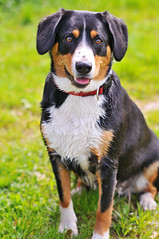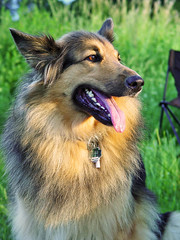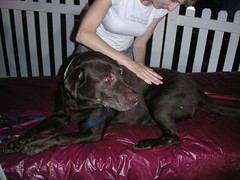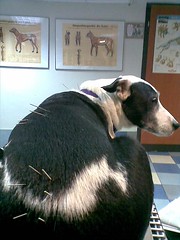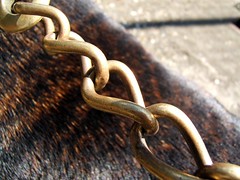A Jake shaped hole in the universe
Wednesday, July 1st, 2009 Old Black Dog
Old Black Dog
Warm brown eyes, clouded by age,
touched lightly with pain.
Deep understanding. Alert for other eyes,
a touch, an opportunity for play or communion.
Soft ears, moving toward my outstretched hand,
leaning into the tenderness.
A weathered torso, thick with fatty tumors, like the
trunk of an ancient tree.
Muscles stiff, contracted against the pain of simple deterioration,
A long life. With a touch, frozen muscles melt, a sigh, a stretch.
Our morning ritual. Sweet. Intimate. An almost invisible thread of daily life.
Comfort for an old dog.
But what of the exquisite texture of black fur against each finger?
Warmth and softness. The sounds of a sigh. The unmistakable
presence of breath – rising and falling.
I am here. You are here. We are here together.
The simplest need.
The rarest pleasure.
Noticed now in its absence.
A Rufus-shaped hole in the universe.
Now, humbled by grief, I see something essential.
We are not alone.
We must not be alone.
We are born to breathe together
Touch one another
See one another deeply
And then we go.
And then we go.
–Lynn Morrison (written on 12/18/07 in memory of Rufus, 11/1/93-11/15/07)
 This poem was written by a client of mine when her dog passed away and gifted to me a couple years ago. At the time I knew it was special and put it away for safe keeping. But it wasn’t until our beloved dog Jake passed away this weekend that I realized how special it was. Lynn has given me permission to share it and I hope it can help others who are also grieving.
This poem was written by a client of mine when her dog passed away and gifted to me a couple years ago. At the time I knew it was special and put it away for safe keeping. But it wasn’t until our beloved dog Jake passed away this weekend that I realized how special it was. Lynn has given me permission to share it and I hope it can help others who are also grieving.
Jake was 14 years old and for the last six months had slowly progressed to the point of barely being able to walk and not always knowing where he was or what was going on. Our lives had come to revolve around making sure we were there for him, cleaning up after him when he had accidents in the house and on himself, and helping him get up and down as he would often get stuck and could no longer go outside on his own.
While I am very sad to have him gone from my life, I realize that the dog I mourn was not the dog that was confused and unable to do any of the things he loved the last few months. It was clearly time for him to pass from this world into a place where he could run again and be free of a body that stopped him from doing anything and just caused him pain and suffering.
The dog I mourn was the happy dog who loved everyone. The dog who would bounce around the house in joy whenever I would get home (even if I had just walked down the steps to the mailbox to get the mail). The dog who heard every sound, kept an eye on everyone and was proud of the job he did protecting our home. He was the dog that sometimes tried too hard and was always inches behind me. The dog that would go up stairs backwards bouncing his bottom into each step so he could watch me coming up behind him the whole way.
 At the dog park he would bound ahead with his curly tail waving in the air. He made friends with everyone, even the dogs who didn’t like anyone. He was the dog that all the little kids wanted to pet. In his later years he would limp up to anyone who passed on the street and captivate them with his kind eyes.
At the dog park he would bound ahead with his curly tail waving in the air. He made friends with everyone, even the dogs who didn’t like anyone. He was the dog that all the little kids wanted to pet. In his later years he would limp up to anyone who passed on the street and captivate them with his kind eyes.
He made us laugh with his inability to realize that he had a whole body sometimes as he was a little on the clumsy side. In fact my son used to introduce Jake as,”this is my dog Jake, he thinks he is a floating head.”
He was always there for us. He helped my son when we was young and was afraid. He helped me through my divorce and slept by my side every night I was alone. He showed us all that love is a wonderful thing and that it can be unconditional. We will miss him very much.
Jake
May 1995-June 29,2009




